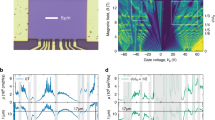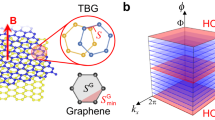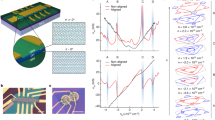Abstract
Electrons moving through a spatially periodic lattice potential develop a quantized energy spectrum consisting of discrete Bloch bands. In two dimensions, electrons moving through a magnetic field also develop a quantized energy spectrum, consisting of highly degenerate Landau energy levels. When subject to both a magnetic field and a periodic electrostatic potential, two-dimensional systems of electrons exhibit a self-similar recursive energy spectrum1. Known as Hofstadter’s butterfly, this complex spectrum results from an interplay between the characteristic lengths associated with the two quantizing fields1,2,3,4,5,6,7,8,9,10, and is one of the first quantum fractals discovered in physics. In the decades since its prediction, experimental attempts to study this effect have been limited by difficulties in reconciling the two length scales. Typical atomic lattices (with periodicities of less than one nanometre) require unfeasibly large magnetic fields to reach the commensurability condition, and in artificially engineered structures (with periodicities greater than about 100 nanometres) the corresponding fields are too small to overcome disorder completely11,12,13,14,15,16,17. Here we demonstrate that moiré superlattices arising in bilayer graphene coupled to hexagonal boron nitride provide a periodic modulation with ideal length scales of the order of ten nanometres, enabling unprecedented experimental access to the fractal spectrum. We confirm that quantum Hall features associated with the fractal gaps are described by two integer topological quantum numbers, and report evidence of their recursive structure. Observation of a Hofstadter spectrum in bilayer graphene means that it is possible to investigate emergent behaviour within a fractal energy landscape in a system with tunable internal degrees of freedom.
This is a preview of subscription content, access via your institution
Access options
Subscribe to this journal
Receive 51 print issues and online access
$199.00 per year
only $3.90 per issue
Buy this article
- Purchase on Springer Link
- Instant access to full article PDF
Prices may be subject to local taxes which are calculated during checkout




Similar content being viewed by others
References
Hofstadter, D. Energy levels and wave functions of Bloch electrons in rational and irrational magnetic fields. Phys. Rev. B 14, 2239–2249 (1976)
Wannier, G. H. A result not dependent on rationality for Bloch electrons in a magnetic field. Phys. Status Solidi B 88, 757–765 (1978)
Středa, P. Quantised Hall effect in a two-dimensional periodic potential. J. Phys. C 15, L1299–L1303 (1982)
Thouless, D., Kohmoto, M., Nightingale, M. & den Nijs, M. Quantized Hall conductance in a two-dimensional periodic potential. Phys. Rev. Lett. 49, 405–408 (1982)
MacDonald, A. Landau-level subband structure of electrons on a square lattice. Phys. Rev. B 28, 6713–6717 (1983)
Koshino, M. & Ando, T. Hall plateau diagram for the Hofstadter butterfly energy spectrum. Phys. Rev. B 73, 155304 (2006)
Nemec, N. & Cuniberti, G. Hofstadter butterflies of bilayer graphene. Phys. Rev. B 75, 201404(R) (2007)
Bistritzer, R. & MacDonald, A. Moiré butterflies in twisted bilayer graphene. Phys. Rev. B 84, 035440 (2011)
Moon, P. & Koshino, M. Energy spectrum and quantum Hall effect in twisted bilayer graphene. Phys. Rev. B 85, 195458 (2012)
Beugeling, W., Goldman, N. & Morais Smith, C. Topological phases in a two-dimensional lattice: magnetic field versus spin-orbit coupling. Phys. Rev. B 86, 075118 (2012)
Gerhardts, R., Weiss, D. & Wulf, U. Magnetoresistance oscillations in a grid potential: indication of a Hofstadter-type energy spectrum. Phys. Rev. B 43, 5192–5195 (1991)
Nakamura, Y., Inoshita, T. & Sakaki, H. Novel magneto-resistance oscillations in laterally modulated two-dimensional electrons with 20nm periodicity formed on vicinal GaAs (111)B substrates. Physica E 2, 944–948 (1998)
Albrecht, C. et al. Fermiology of two-dimensional lateral superlattices. Phys. Rev. Lett. 83, 2234–2237 (1999)
Schlösser, T., Ensslin, K., Kotthaus, J. P. & Holland, M. Landau subbands generated by a lateral electrostatic superlattice: chasing the Hofstadter butterfly. Semicond. Sci. Technol. 11, 1582–1585 (1996)
Albrecht, C. et al. Evidence of Hofstadter’s fractal energy spectrum in the quantized Hall conductance. Phys. Rev. Lett. 86, 147–150 (2001)
Geisler, M. C. et al. Detection of Landau band coupling induced rearrangement of the Hofstadter butterfly. Physica E 25, 227–232 (2004)
Melinte, S. et al. Laterally modulated 2D electron system in the extreme quantum limit. Phys. Rev. Lett. 92, 036802 (2004)
Harper, P. G. Single band motion of conduction electrons in a uniform magnetic field. Proc. Phys. Soc. A 68, 874–878 (1955)
von Klitzing, K., Dorda, G. & Pepper, M. New method for high-accuracy determination of the fine-structure constant based on quantized Hall resistance. Phys. Rev. Lett. 45, 494–497 (1980)
Kuhl, U. & Stöckmann, H. J. Microwave realization of the Hofstadter butterfly. Phys. Rev. Lett. 80, 3232–3235 (1998)
Jaksch, D. & Zoller, P. Creation of effective magnetic fields in optical lattices: the Hofstadter butterfly for cold neutral atoms. N. J. Phys. 5, 56 (2003)
Xue, J. et al. Scanning tunnelling microscopy and spectroscopy of ultra-flat graphene on hexagonal boron nitride. Nature Mater. 10, 282–285 (2011)
Decker, R. et al. Local electronic properties of graphene on a BN substrate via scanning tunneling microscopy. Nano Lett. 11, 2291–2295 (2011)
Yankowitz, M. et al. Emergence of superlattice Dirac points in graphene on hexagonal boron nitride. Nature Phys. 8, 382–386 (2012)
Dean, C. R. et al. Boron nitride substrates for high-quality graphene electronics. Nature Nanotechnol. 5, 722–726 (2010)
Dean, C. R. et al. Multicomponent fractional quantum Hall effect in graphene. Nature Phys. 7, 693–696 (2011)
Li, G. et al. Observation of Van Hove singularities in twisted graphene layers. Nature Phys. 6, 109–113 (2010)
Wallbank, J. R., Patel, A. A., Mucha-Kruczynski, M., Geim, A. K. & Fal’ko, V. I. Generic miniband structure of graphene on a hexagonal substrate. Preprint at http://arxiv.org/abs/1211.4711 (2012)
Giovannetti, G., Khomyakov, P., Brocks, G., Kelly, P. & Van Den Brink, J. Substrate-induced band gap in graphene on hexagonal boron nitride: ab initio density functional calculations. Phys. Rev. B 76, 073103 (2007)
Ramasubramaniam, A., Naveh, D. & Towe, E. Tunable band gaps in bilayer graphene-BN heterostructures. Nano Lett. 11, 1070–1075 (2011)
Acknowledgements
We thank A. MacDonald for discussions. A portion of this work was performed at the National High Magnetic Field Laboratory, which is supported by US National Science Foundation cooperative agreement no. DMR-0654118, the State of Florida and the US Department of Energy. This work is supported by AFOSR MURI. J.K. and M.I. were supported by the US National Science Foundation under grant no. 0955625. K.L.S. was supported by DARPA under Office of Naval Research contract N00014-1210814. P.K. and F.G. acknowledge sole support from the US Department of Energy (DE-FG02-05ER46215).
Author information
Authors and Affiliations
Contributions
C.R.D., P. Maher, L.W., C.F., F.G. and Y.G. performed device fabrication and transport measurements. J.K. and M.I. performed AFM measurements. P. Moon and M.K. provided theoretical support. K.W. and T.T. synthesized the hBN samples. K.L.S., J.H. and P.K. advised on experiments. C.R.D., P. Maher, P. Moon, M.K., J.H. and P.K. wrote the manuscript in consultation with all other authors.
Corresponding author
Ethics declarations
Competing interests
The authors declare no competing financial interests.
Supplementary information
Supplementary Information
This file contains Supplementary Text and Data 1-7, Supplementary Figures 1-6 and additional references. (PDF 1786 kb)
Rights and permissions
About this article
Cite this article
Dean, C., Wang, L., Maher, P. et al. Hofstadter’s butterfly and the fractal quantum Hall effect in moiré superlattices. Nature 497, 598–602 (2013). https://doi.org/10.1038/nature12186
Received:
Accepted:
Published:
Issue Date:
DOI: https://doi.org/10.1038/nature12186
This article is cited by
-
Engineering correlated insulators in bilayer graphene with a remote Coulomb superlattice
Nature Materials (2024)
-
Atomic-scale manipulation of buried graphene–silicon carbide interface by local electric field
Communications Physics (2024)
-
Aubry–André–Harper model: multifractality analysis versus Landauer conductance for quasicrystal chains
Indian Journal of Physics (2024)
-
Twistronics and moiré excitonic physics in van der Waals heterostructures
Frontiers of Physics (2024)
-
Reconfigurable moiré nanolaser arrays with phase synchronization
Nature (2023)
Comments
By submitting a comment you agree to abide by our Terms and Community Guidelines. If you find something abusive or that does not comply with our terms or guidelines please flag it as inappropriate.



